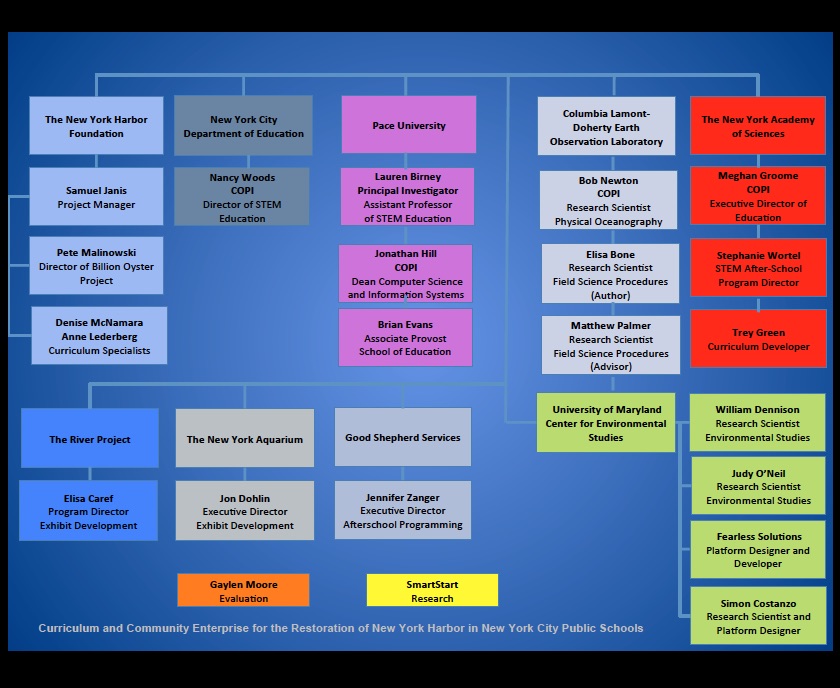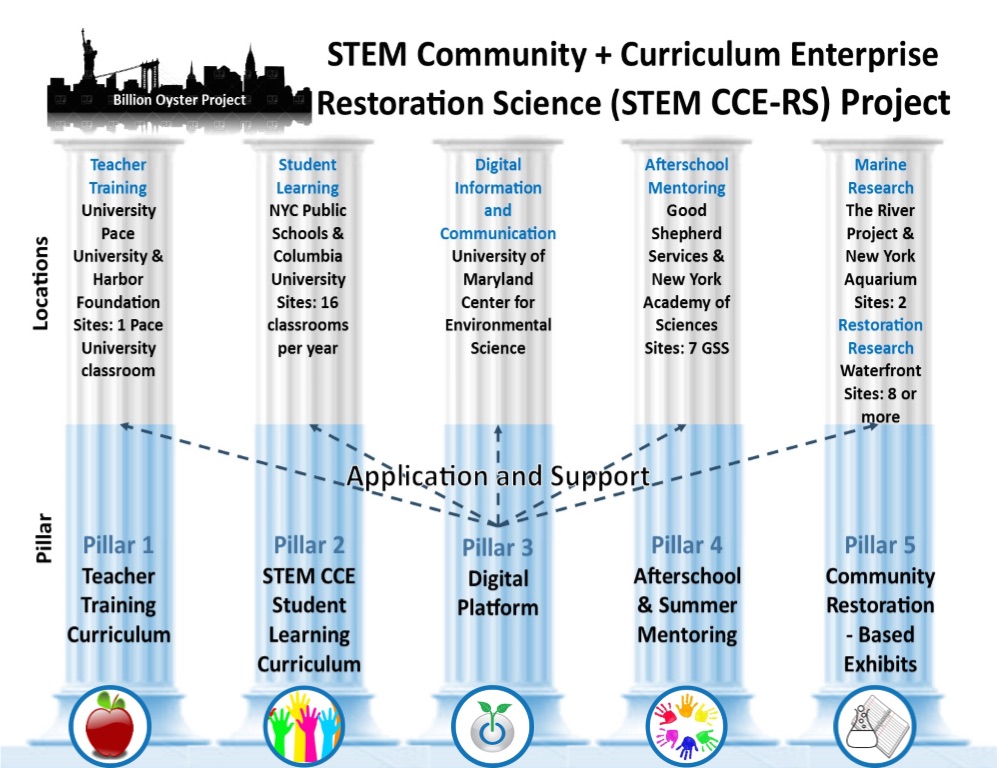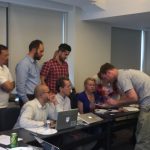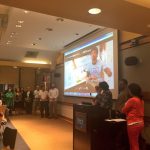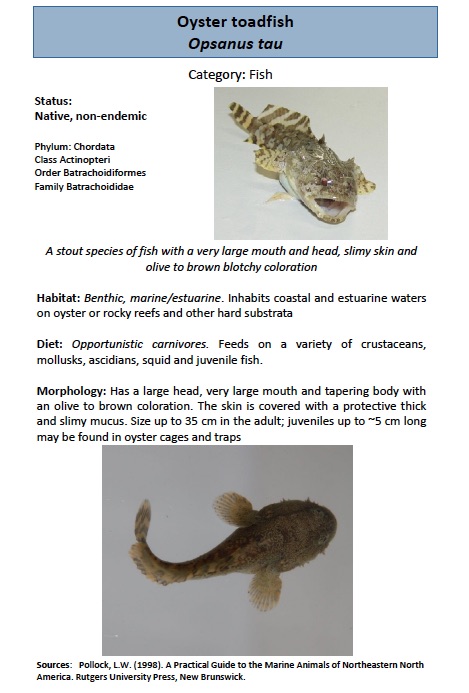Emerging Connections
The Billion Oyster Project
Restoring New York Harbor in New York City Public Schools
Connected Science Learning May-July 2017 (Volume 1, Issue 3)
By Lauren Birney
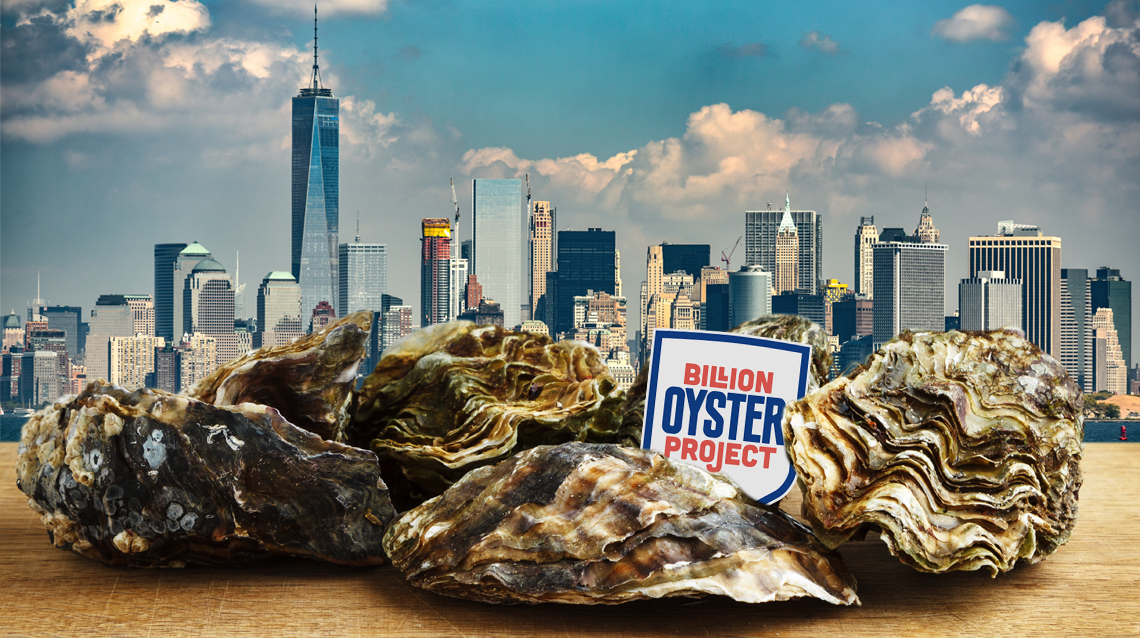
In the Billion Oyster Project, middle school students study and conduct field research of New York Harbor and its watershed to support restoration of native oyster habitats. The project is developing and testing a model that integrates curriculum and community enterprise to connect urban students to natural settings.
The Curriculum and Community Enterprise for the Restoration of New York Harbor Through New York City Public Schools is a project that is both an education and restoration initiative. The project began with the vision that public school curricula— particularly in STEM-C (science, technology, engineering, and math, plus computing) content areas—can be enhanced by explicitly linking teaching and learning to a localized environmental science project that demands authentic research, data collection, and experimentation. In New York City, there are numerous local environmental problems that merit student inquiry research; however, none is more fundamental than the question of human impacts on the city’s watershed.
New York City is the terminus of a regional watershed that encompasses more than 17,000 square miles, four states, and approximately 20 million people. When the water of the combined Hudson, Raritan, and Bronx rivers arrives in New York Harbor, it meets the Atlantic Ocean and forms one of the largest, well-protected natural harbors in the world. The 300-square-mile estuary that surrounds and comprises New York City was, at the time of European arrival, also one of the most biologically productive and resilient ecosystems on the planet. For more than 250 years, the vast fisheries of the Upper New York Bay and Hudson River nourished the people and propelled the wealth of the city. Arguably, no species was more essential—or more abundant—in building New York City than the native East Coast oyster, Crassostrea virginica. The historical extent of the New York Bay oyster included more than 200 square miles of reef and hundreds of billions, if not trillions, of individuals. At this scale, the oyster was the original ecosystem engineer of New York Harbor. Its power to attenuate waves, continuously filter impurities, and shelter complex communities of marine life is unmatched and irreplaceable. However, the oyster population has fallen due to pollution and overfishing.
The Curriculum and Community Enterprise for Restoration Science (CCERS) is a partnership model that involves a 3,000 of New York City’s 1.1 million public school students to date. CCERS partners have created an innovative STEM-C curriculum for teachers; a meaningful, highly engaging basis of learning for students; and a unifying platform around which to engage a diverse community of STEM-C professionals, graduate and postdoctoral scientists, and out-of-school time (OST) educators. The process of keystone species restoration is necessarily multidisciplinary, hands-on, and scientific. In the case of oysters in New York Harbor, the undertaking has required the expertise of biologists, ecologists, engineers, oceanographers, and computer scientists, all working collaboratively in classroom, laboratory, and field settings. These diverse disciplines are embedded in the formal school-based and after-school-based curriculum that forms the foundation of the Billion Oyster Project (BOP), and these content areas are anchored in strict core competencies of science and mathematics.

The CCERS Project Mission
The project’s mission is to meaningfully connect teaching and learning to the restoration of New York Harbor and, as a result, create enhanced learning and life outcomes for students historically underrepresented in STEM fields.
CCERS’s goals are:
- Increase the quality and effectiveness of STEM-C teaching and learning for middle school students in urban public schools through implementation of the CCERS model
- Increase the knowledge and instructional skill of teachers, informal educators, and STEM-C professionals who work in economically disadvantaged neighborhoods, so that these educators can include restoration science and research project–based learning
- Increase New York City public middle school students’ knowledge of and interest in STEM-C
The Collaborative Partnership Model
The CCERS model consists of five education resource pillars that function in combination and independently to support middle school students’ learning and classroom teacher/OST educator training across the five physical settings in the partnering institutions: the university classroom for teacher training, the school classroom, waterfront field sites for restoration research, an aquarium/marine science research facility, and an OST/after-school program site. The pillars work to support project implementation in one or more settings. The partner responsibilities and scope of work are listed in Figure 1.
Figure 1
Partners Institutions for the BOP STEM-C CCERS Project
| Partner Institution | Scope of Work |
|---|---|
| New York Academy of Sciences (NYAS) | NYAS developed a sustained programmatic relationship with Good Shepard Services, one of the largest, most successful OST providers in the city. This direct working relationship, established solely by way of BOP STEM-C, provides NYAS a stable platform for rolling out and refining new and highly innovative programming. |
| New York Harbor Foundation (NYHF) | The project formalized and expanded the place-based environmental STEM curricula that New York Harbor School have developed over the past 10 years and made it exportable to middle and high schools across New York City. |
| Pace University (prime institution) | The project enriched the curriculum offered by Pace University’s School of Education. The BOP STEM-C curruiculum improves the teaching fellows’ comfort with place-based, experiential, environmental learning and broadens opportunities for experiential learning at Pace. |
| New York City Department of Education (NYCDOE) | The project allows NYCDOE to broaden the curriculum options available to middle school science programs. BOP STEM-C deepens the connections between NYCDOE schools and their surrounding environment by anchoring science curricula to place and a shared vision for a healthy urban ecology. |
| New York Aquarium (NYA) New York Aquarium (NYA) | Building on its world-renowned expertise in marine science education programming, NYA is expanding its estuary wing and developing a living reef exhibit to increase New Yorkers’ understanding of and personal connection to their local marine ecosystems. |
| The River Project (TRP) | TRP has made a significant enhancement to its hands-on exhibits of the Hudson River Estuary. The BOP estuarium, which is currently being built, will allow visitors to Pier 40 more intimate, multimodal engagement with environmental restoration, which will make the pier a more attractive and engaging center. This is due to be complete in spring 2018. |
| Good Shepherd Services (GSS) | The project has allowed GSS to implement important upgrades to the depth and rigor of its after-school offerings in science and technology. |
| Gaylen Moore Evaluation Services | Gaylen Moore is the external evaluator for the project and leads the local data collection efforts in concert with the project researchers at SmartStart Evaluation and Research Services. |
| SmartStart ECS | SmartStart is the lead consultant for the project’s research and strategic planning. The project allows SmartStart to build upon its expertise in place-based environmental education methods. |
| Columbia University’s Lamont–Doherty Earth Observatory (CLDEO) | CLDEO leads the development of the student field research procedures for oyster gardening and restoration projects, supports teacher training, and advises on the environmental BOP STEM -C curriculum. |
| University of Maryland Center for Environmental Science (UMCES) | The project has allowed UMCES to expand its client base for its educational technology. The project has also allowed UMCES to develop new technological expertise. |
The five resource pillars are (Figure 2):
- Teacher training curriculum
- Student learning curriculum (classroom and field)
- The CCERS digital platform
- OST STEM mentoring curriculum
- Aquarium exhibits and learning guides
Each of these pillars is described in this article.
Figure 2
BOP STEM-C CCERS
This diagram of the five project pillars shows how the individual partners work collaboratively to create the necessary project synergy.
Pillar 1: Teacher Training Curriculum (CCERS Teacher Fellowship)
The CCERS Teacher Fellowship is a two-year professional development program that trains teachers to engage their students in hands-on environmental science and restoration ecology in and around New York Harbor (see Figure 3). The fellowship is open to New York City Department of Education middle school teachers working in Title I–funded schools. Pace University’s School of Education hosts the fellowship classes at its lower Manhattan campus, and the New York Harbor Foundation runs outdoor field trainings at BOP headquarters on Governors Island. Classes and trainings are taught by guest content area experts and scientists from Columbia University’s Lamont Doherty Earth Observatory and curriculum specialists from the New York Harbor Foundation.
The CCERS fellowship is the central pillar of a National Science Foundation–funded (DRL #1440869) education research project. In addition to engaging students in hands-on environmental field science during their regular school day, the CCERS project also strongly emphasizes the use of computer science and digital tools for environmental monitoring, citizen science, stewardship, and advocacy. Through participation in the fellowship, inservice teachers play a key role in advancing the CCERS model and answering the project’s core research questions.
CCERS teaching fellows are provided with technical, material, and financial support with which to implement the CCERS curriculum in their classrooms and in the field. The fellowship class covers core content and scientific practices in marine biology, water chemistry, ecological history, urban design, and environmental fieldwork. Three mandatory field training days on Governors Island cover BOP field science protocols and use of the “Oyster Restoration Station,” an oyster grow-out unit and marine science experimental platform designed for middle school classes of up to 35 students.
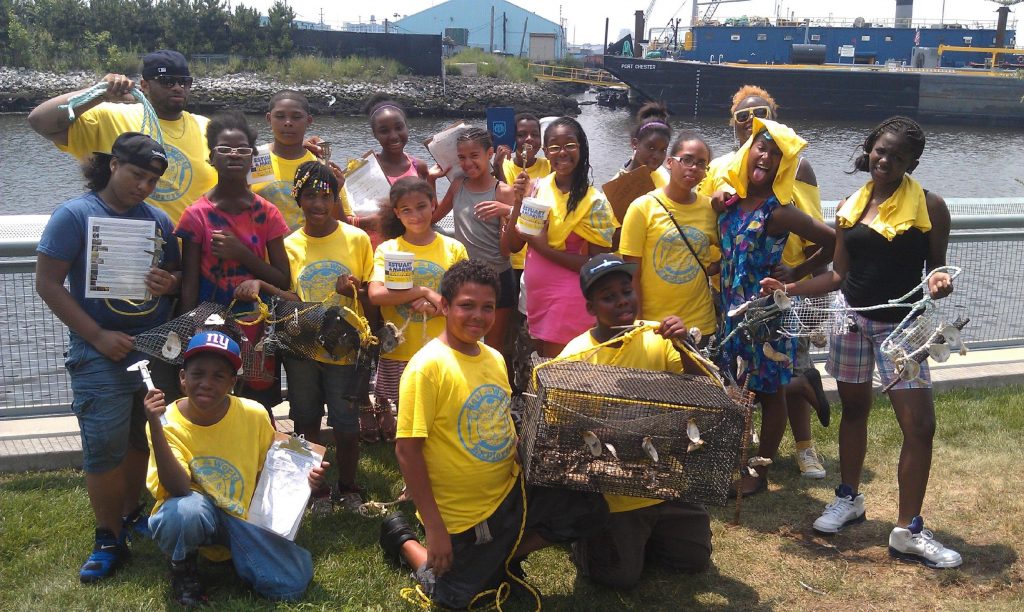
The Oyster Restoration Station also includes advanced water-quality monitoring equipment, the BOP mobile app for data collection, and the online dashboard for statistical analysis. Fellows are assigned a waterfront site near their school to install the restoration station and conduct four or more monitoring expeditions per year with select groups of students.
CCERS teaching fellows are also encouraged to take trips to partner institutions, museums, aquariums, and STEM industry field sites. To support their participation in all five pillars of the project, teachers are given an annual stipend and schools receive additional funds annually for related expenses, including monitoring supplies, books, transportation, substitute coverage, or advanced underwater equipment such as the Open Remotely Operated Vehicle. Some further information, photos, and teacher resources are available online.
Figure 3
Summary of Teacher Fellowship Activities
| Activities | Year 1 Requirements | Year 2 Requirements |
|---|---|---|
| Fellowship evening meetings (second Tuesday of the month at Pace) | First-year fellows attend all nine meetings (five in the spring, four in the fall). | Second-year fellows attend one meeting per year to present micro–teaching modules. |
| Field trainings (Saturdays on Governors Island) | First-year fellows attend all three field training days. | Second-year fellows are encouraged, but not required, to attend. |
| Annual BOP symposium | First-year fellows attend the annual symposium and may bring their students. | Second-year fellows attend the annual symposium and are required to bring students to present. |
| Restoration station monitoring trips | First-year fellows conduct two trips in the fall. | Second-year fellows conduct two trips in the fall and two trips in the spring. |
| Annual event at Pace University: The STEM Collaboratory NYC | Optional | Required |
| Aquarium and reef exhibit field trips | Optional but encouraged | Optional but encouraged |
Related Teacher Fellowship Activities
- Evening meetings at Pace University’s School of Education: The CCERS fellowship course meets monthly. The monthly meeting is the anchor experience of the BOP fellowship and provides a supportive space for community building, marine STEM technical learning, and curriculum testing and development. Each session includes dinner and informal networking, a science content workshop with a guest expert, peer-to-peer curriculum development, and a micro teaching module. First-year fellows are expected to attend all nine sessions, whereas second-year fellows only attend one session for micro teaching presentations and to mentor first-year fellows.
- Field training days: First-year fellows are required to attend three full days of training on Governors Island to build an Oyster Restoration Station, learn BOP field science procedures, and practice/simulate monitoring expeditions they will take with students. This is a more in-depth, technical version of BOP’s two-day public Oyster Restoration Station training, which occurs quarterly throughout the year. The field training also provides fellows with an advanced monitoring kit, including water quality sensors and a class set of tablet computers. Field training days take place on three separate Saturdays, one per month in May, June, and September. We have created a Field Science Manual that provides fellows with guidance and resource access while in the field (Figure 4).
- Annual event at Pace University: The STEM Collaboratory NYC: CCERS teacher fellows are asked to attend a three-hour evening celebration and dinner in late June to present their work to date to Pace faculty, STEM professionals, and the broader community of project supporters. The project also supports a summer institute for middle school students, during which they study technology in relation to environmental science while working with teachers, scientists, and STEM industry leaders. This event allows all of these individuals to network with one another. Additionally, there are summer support opportunities that allow students to go beyond what is expected of them in them in the classroom and explore further areas of interest. The Summer STEM Institute at the STEM Collaboratory NYC located at Pace University for middle school students also follows this event.
Pillar 2: Student Learning Curriculum; Field Science and Environmental Research
To date, the CCERS team and the teaching fellows have developed 74 environmentally based lesson plans that fall into five main areas:
- New York’s urban ecosystem,
- oysters,
- mobile organisms,
- sessile organisms, and
- water quality.
All lesson plans are inquiry-based, with an emphasis placed on investigation and research. Students are encouraged to think and explore beyond the obvious. Students not only learn the environmentally based content, but also engage in data collection and research, skills embedded in each lesson that are essential to student success in the sciences. The lesson plans are freely accessible to all teachers.
Teachers and students work in the field alongside research scientists from Columbia University as they collect data pertaining to water quality, site conditions, oyster measurements, settlement tile (which allows for the growth of organisms), sessile organisms, mobile organisms, and general site conditions. This field information is then discussed in the fellows’ classrooms. Teachers are also given an oyster tank that students maintain and monitor in their classrooms.
Related Teacher Fellowship Activities
-
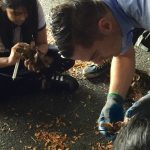
Teachers and middle school students working together in New York Harbor on a field training day. Annual BOP STEM Symposium on Governors Island: The CCERS Symposium is the annual gathering of BOP schools, scientists, and partners to present research and results, network with peers, discuss challenges, and celebrate. BOP schools are invited to bring a group of up to 30 students. These students are the ones who have been most involved with BOP field science and restoration station monitoring throughout the year. Students are asked to present their research through posters or electronic media presentations. The Symposium is a full-day event held in mid-June, and it also features educational theater (an interactive musical performance for students), tours of Harbor School hatchery and reef restoration sites, and lunch and oyster shucking for all participants.
-
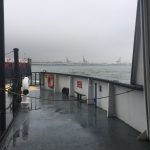
Ferry to Governor’s Island with Red Hook in the background, New York Harbor. Restoration station monitoring trips: Each participating school is provided a waterfront site at which to install the class restoration station and conduct monitoring trips with students. Each participating teacher must take at least four monitoring trips per year, two in the fall of each academic year and two in the spring. A monitoring trip involves a class of up to 34 students and at least three adults. The class can be split into five groups, with each group assigned to one or more of the five field science protocols. Participating students must be trained in BOP field science procedures, use of equipment, and the BOP input app before going out in the field. For this purpose, a set of prefield trainings is provided to teachers as part of the 74 lesson plans the CCERS curriculum offers. Teachers are responsible for ensuring students upload the full dataset to the online BOP Field Science Dashboard after each expedition. Field trips are structured by the individual schools sites and vary depending on schools and teachers.
-
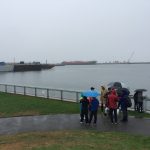
A day on the waterfront: Students collect data in Red Hook. Field trips to reef exhibits and science institutions: Teaching fellows are encouraged to take at least one trip with students per year to complement restoration station monitoring fieldwork. Possible trip destinations include, The River Project, the New York Aquarium, the New York Academy of Sciences, and other partner institutions tied to the project. School subsidies can be used to cover the costs of these excursions.
Pillar 3: The CCERS Digital Platform and Technology
The CCERS Digital Platform is web-based, cloud-hosted, and optimized for mobile and tablet devices. It is a practical tool for enabling and learning environmental field research methods, data collection, statistical analysis, and basic computer programing. It has been designed for mobile data collection and analysis in the classroom, but students can access and use the platform at any time through any internet connection. The user interface is expressly designed for middle school students, with advanced functionality for high school apprentices who help with the CCERS after-school programs and science teachers. It provides compelling graphical illustrations of key content and an array of interactive tools for uploading and analyzing data. It also includes built-in programming and design features that allow students to create their own dashboards, widgets, and data information streams. The photos below show images from an underwater livestream, which allow students to view the organisms in real time.
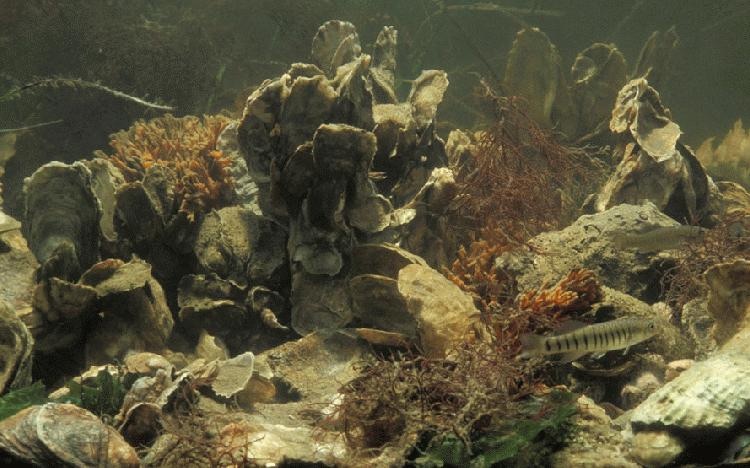
The five main features of the platform are:
- students upload, share, and compare data in real time with other schools and sites across the city using tablets (provided by the project) or personal smartphones;
- students learn database information management, graphing, and basic principles of statistics with desktop-based interactive tools;
- students create their own dashboards with widgets to display their environmental monitoring data and web-based feeds;
- students view Harbor Literacy modules and content through interactive and graphical displays; and
- teachers can access a curriculum repository with a built-in discussion board to share, critique, and collaboratively develop CCERS-related educational resources.
All teachers are invited to sign up for events that allow teachers to deepen their understanding of the curriculum and practice with the software. These events are open to the public.
Pillar 4: STEM After-School Mentoring
The CCERS after-school mentoring is an expansion of NYAS’s successful STEM mentoring program, which serves seven Good Shepherd Services (GSS) after-school sites. Good Shepherd Services is a family service and youth development agency with more than 80 programs that serve over 26,000 children, youth, and families each year. Focusing on high-need communities in Brooklyn and the Bronx, GSS provides a broad array of individual, family, and school-based services to prevent youth from becoming disconnected from family, school, and society. Students participating in CCERS at their schools are encouraged, but not required, to attend the after-school programs.
CCERS’s after-school program uses a STEM-C curriculum taught by scientists from NYAS and high school apprentices. Additionally, graduate (PhD students) and postdoctoral mentors from NYAS work with their mentees on a weekly basis from November through April. They provide additional tutoring, training, and guidance in STEM subjects. The scientists receive training and ongoing professional development to support these students, and they also meet with their mentees weekly to provide STEM content area support. These graduate student mentors have been trained by NYAS in mentorship and STEM-C content support.
The after-school curriculum complements the in-school curriculum in that it provides additional skill-building lessons, STEM competency refinement, and practice that infuses other content areas with STEM. The content focuses on restoration ecology, water quality, the environmental effects of water runoff, and oysters.
Summer STEM programs and after-school STEM activities are also available to students. Middle school students spend time on the water learning how to hoist sails, read compasses, navigate and steer vessels, address watercraft safety, and tie knots. They also kayak, swim, build robots, and learn about environmental restoration and marine biology.
Pillar 5: CCERS Museum Exhibits and Expositions
Pillar 5 is a permanent, full-scale estuary exhibit with accompanying educational programs created by the New York Aquarium and The River Project, which will house the exhibit. CCERS teachers and students take field trips that allow students to touch, feel, and interact with the various organisms found in New York Harbor. After returning to the classroom, teachers review the topics discussed in the exhibitons and incorporate these ideas into the classroom curriculum. Students are also encouraged to think about these topics as ideas for research and further investigations.
Both CCERS exhibits are continuing to grow, expand, and morph into meaningful experiences for teachers, students, and visitors. The interactive, engaging, and inquiry-based exhibits are also open to the general public. The CCERS Environmental Science at the New York Aquarium exhibit is due to open in spring 2018.
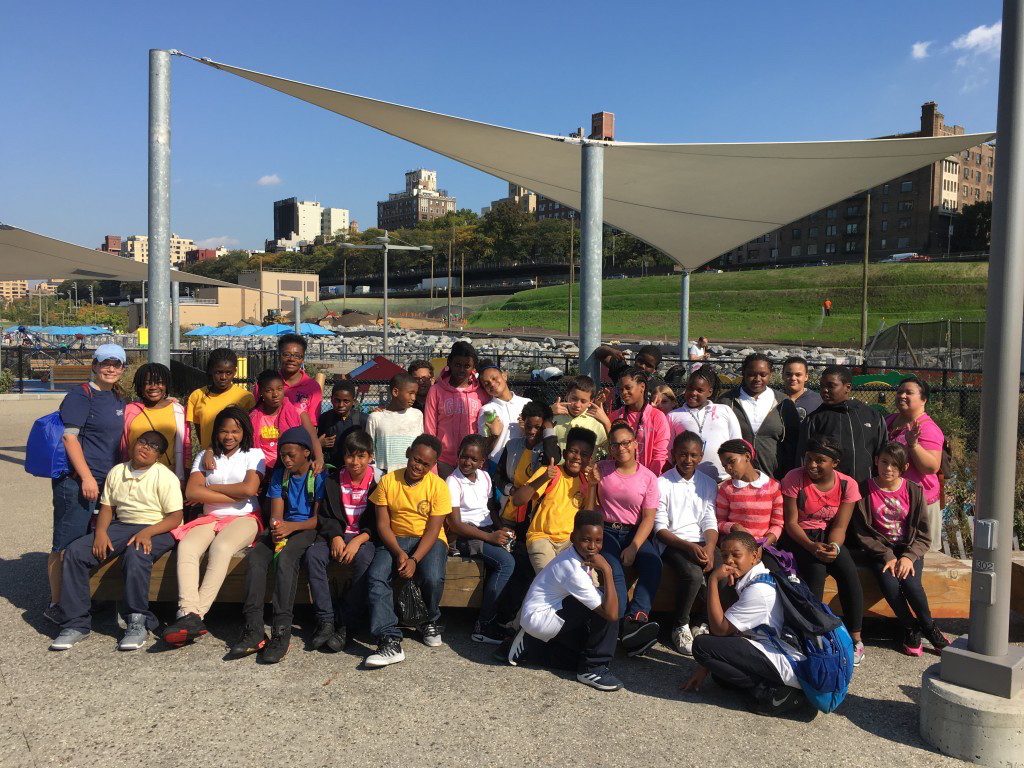
Lessons Learned and Early Evaluation Results
CCERS facilitates partnerships between scientists and middle school educators to encourage ecological restoration and environmental monitoring projects. The educational model CCERS uses is designed to “wrap around” the student, including classroom instruction, field science, after-school programs, and engagement with the student’s community.
Findings from our program evaluation suggest that CCERS fosters our teacher fellows’ increased engagement with STEM content materials in their classrooms. The added scientific support, materials, resources, and field research create and establish an environment more conducive for teachers promoting and engaging in citizen science and inquiry-based learning. Teachers also indicated an increase in using inquiry-based learning practices in their classrooms as a result of the teacher training fellowship and field science expeditions. Students indicated feeling a stronger sense of interest in STEM-C fields through their exposure to citizen science, field research, inquiry-based learning, and problem-solving instructional practices in the classroom. These results are promising and certainly speak to the achievement of the project goals. As the project enters into year 3, it looks to build upon these initial indicators (see Resources for more detailed evaluation data).
Conclusion
CCERS seeks to be a fully scalable and transferable model, adaptable to other American school districts. Leveraging our evaluative research and open-source technology platform, the program can be readily expanded to the additional 393 public middle schools in New York City. Ultimately, the model can be adapted to restoration, environmental research, and sustainability projects in national and international communities, creating broad impacts on mainstream science pedagogy. The program exclusively engages public schools in neighborhoods with persistent poverty and low socioeconomic indicators. The CCERS model demonstrates that physically engaged, field-based, authentic scientific research can overcome systemic inequities to equalize learning for student groups currently underrepresented in the STEM-C professions.
This model suggests that with appropriate application of technical infrastructure, intensive teacher training, and holistic curricular scaffolding, authentically inquiry-based, socially connected science learning can be mainstreamed in the nation’s largest urban school system. Significantly, large-scale success is achieved by engaging active STEM-C professionals, whose capacities are leveraged through appropriate professional development for inservice science faculty and the appropriate use of digital technologies, professional networking, and a replicable field-based curriculum. The metadata and evaluative instruments generated during the project will help identify those characteristics of the curriculum that are essential to broadening its reach, linking curricula in other school districts with local problems in restoration and sustainability.
The CCERS project’s additional teacher support, resources, training, and field research all have the capacity to impact teaching practices and, ultimately, student achievement. CCERS looks to teachers to share their classroom challenges, resource needs, and instructional practice struggles. The program’s goal is to alleviate as many of these issues as we possibly can, so that teachers are able to provide students with all the necessary components of being stellar student and society members who are also aware of the environmental challenges faced by their community.
Pete Malinowski, director of the Billion Oyster Project, discusses its impact on New York Harbor (CCERS is mentioned around the 35 min. mark).
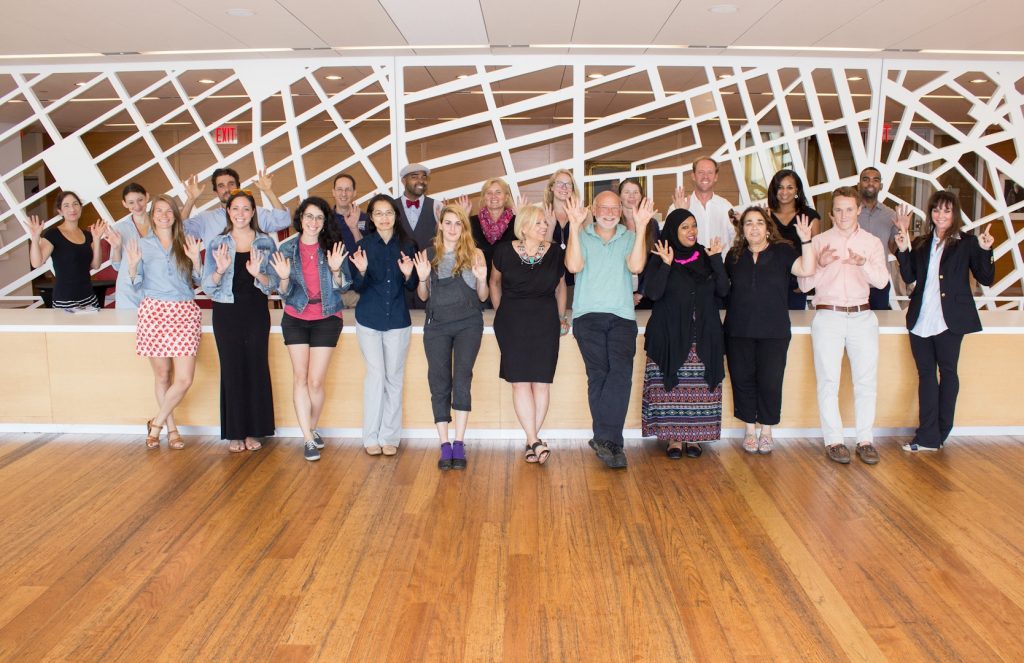
The CCCERS project team, 2015.
Lauren Birney (lbirney@pace.edu) is assistant professor of STEM education in the School of Education at Pace University in New York, New York. You can follow her on Twitter: @lbbirney.



